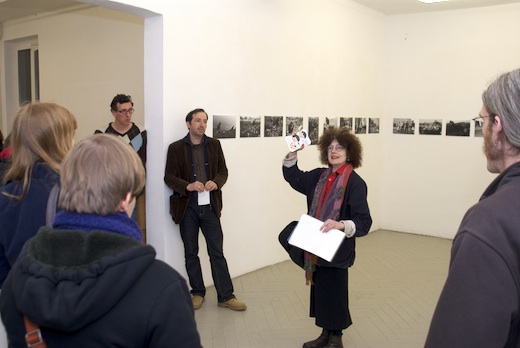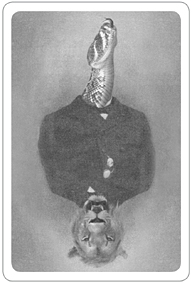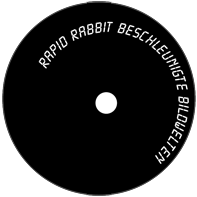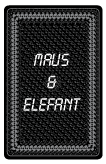RAPID RABBIT — BESCHLEUNIGTE BILDWELTEN
Programmreihe der FRISE
in Zusammenarbeit mit
Ursula Panhans-Bühler
Eine Standortbestimmung
in Umbruchzeiten
30 Wochen Veranstaltungen
Das Programm 2011
in 5 Blöcken zum Ausklappen
Bilder, Lectures,
Beschreibungen, Links.
RABBIT'S TRAIL
Hase & Igel 
Mi. 2. März | » Start
Chatroulette-Installation / Wandbild Daniela Witzel
Eröffnung Internetcafé
Mi. 9. März | » Streetart
Vortrag: Hartwig Scharf, Veränderungen in der Graffiti-und Streetartszene;
Mi. 16. März | » Talk
Einstieg ins Thema mit Lecture-Ausschnitten des Medienkünstlers und -philosophen,
Yariv Alter Fin
Mi. 23. März | » Sound
Jens Röhm, 8-Kanal-Soundinstallation
Untitled (Große Bergstraße, 2006) sowie andere Sound-Arbeiten, mit Dr. Kathrin Wildner, Stadtethnologin
So. 27. März | » Video
John Whitney "Screening Room"
Mi. 30. März | » Film
Thom Anderson "Los Angeles Plays Itself"
Mi. 6. April | » Labor
Studierende der Klasse Jeanne Faust (HfbK) geben ihren Kommentar
Schlange & Löwe 
Mi. 13. April | » Start
Chen Shihong, Fotografien aus Hangzhou, China / Lev Yilmaz / Wang Bo u.a.
Mi. 20. April | » Vortrag + Video,
Liu Ke
Mi. 27. April | » Gespräch
Henri Kowalski und Tobias Haas, DESY Hamburg
Mi. 4. Mai | » Künstlergespräch
Monica Studer und Christoph van den Berg
Mi. 11. Mai | » Soundabend Ansgar Wilken: LOOP YOUR LIFE
Mi. 18. Mai | » Labor
Public Pad: Studierende der HfbK aus der Klasse Michaela Melián beschließen den 2. Block von RAPID RABBIT
Maus & Elefant 
Mi. 25. Mai | » Start
Roy Arden, Michael Best, Allan Dorr, Philipp Haffner, Jochen Lempert, Willem Oorebeek, Katharina Salzbrunn, Ralf Weißleder
Mi. 1. Juni | » FILM
Lutz Dammbeck, „Das Netz“
Mi. 8. Juni | » Ausstellung
„Négatif Agentif“
von Norbert Bayer
So. 12. Juni | » Künstlergespräch
Norbert Bayer mit Naoko Kaltschmidt
Mi. 15. Juni | » Ausstellung
Martin Zellerhoff –
„Verblüffende Farben“
Fotografie
So. 19. Juni » Künstlergespräch
Peter Piller + Martin Zellerhoff + Ludwig Seyfarth
Präsentation und Künstlergespräch
Mi. 22. Juni | » Soirée analogique
Rosita Serrano und andere Schinken –
Schellackplatten und 8mm-Filme
Mi. 29. Juni | » Installation + Sound Event
Licht-Rauminstallation von
Jeongmoon Choi, „Room in Room“
David Okoampah und Tobias Böhm Sound
Sa. 2. Juli | » Hasen-Halbfinale
Ein Abend im Dunkeln:
Pitt Sauerwein, Jeongmoon Choi, Kenzo Onoda, Hasenboyband
Schweine & Weltall

Mi. 7. September » Start
Harun Farocki, Wolfgang Bellwinkel, Alexander Gardner, Barbara Hlali,
William E. Jones, David O’Reilly, Thomas Rieck, Christoph Rothmeier, Katharina Salzbrunn, Youssef Tabti
So. 11. September » Film
Avi Mograbi „Z32“
Mi. 14. September » Vortrag
Vortrag Petra Bopp,
„Die Minenprobe“
Private Kriegsfotografie von Wehrmachtsoldaten im Kontext
Mi. 21. September » Film
Philip Scheffner, „Halfmoon Files“
Mi. 28. September » Reboot
Film Night – Animation und Games
Mi. 5. Oktober » Vortrag
Franziska Beyer
»Machinima – Filme, die in PC-Spielen gedreht werden«
So. 9. Oktober » Filmclub
Allan Dorr stellt vor:
» Scott Pilgrim vs. The World
*An epic of epic epicness*
Mi. 12. Oktober » Labor
Guild Wars Game Night
mit Jakob Meyer
Eine Einführung
Herr & Huhn
Mi. 19. Oktober » Start
Arbeiten von Qiu Anxiong, Martin Arnold, BitteBitteJaJa, Ursula Bogner, Jochen Lempert, Achim Lengerer
Mi. 26. Oktober » Konzert
Jan Jelinek und Andrew Pekler improvisieren zu Ursula Bogners Kompositionen, die anhand von Originalbändern rekonstruiert werden.
Mi. 2. November | » Film
„We shall survive in the memory of others“
Drei Gespräche mit Vilém Flusser
On technical images, chance, consciousness and the individual (1991)
On religion, memory and synthetic image (1990)
On writing, complexity and the technical revolutions (1988)
Mi. 9. November | » Vortrag
Claudia Reiche: »Digitale Körper, geschlechtlicher Raum – Das medizinisch Imaginäre des ›Visible Human Project‹«
Mi. 16. November | » Performance
Achim Lengerer: Little Body Beating Heart: Rehearsals with Sally.
Mit Sally Musleh Jaber und Achim Lengerer
So. 20. November | » Vortrag
Bjørn Melhus im Gespräch mit Ursula Panhans-Bühler über neueste Projekte
Mi. 23. November | » Labor
Studierende der Muthesius Hochschule Kiel geben Ihren Kommentar
SCHLANGE & LÖWE | MITTWOCH 13. APRIL: START
Chen Shihong: illegale Müllarbeiter in China
Levni Yilmaz: Tales of Mere Existence
Wang Bo u. a.
Chen Shihong, „Illegale Müllarbeiter in China“, 45 S-W-Bilder in erzählender Reihenfolge
 Ausstellungseröffnung
Ausstellungseröffnung
“Sie sind wie Zugvögel im rastlosen Getriebe der Stadt. Obwohl einige von ihnen viele Jahre in der Stadt gelebt haben, bleibt die Stadt im Grund ihrer Seelen immer ein vorübergehendes Zuhause. Sie trennen Müll, bereiten Ressourcen der Stadt auf, lösen damit zugleich selbständig Probleme der Tätigkeit von Millionen von China's beschäftigungslos gemachter Landbevölkerung.”
– Zitat Shihong
» Einführender Text von Ursula Panhans-Bühler sowie das ausführliche Statement von Chen Shihong auf Englisch)
In den Jahren 2006 bis 2008 machte Chen Shihong in seiner Heimatstadt Dalian, inzwischen längst ebenfalls eine Viele-MillionenStadt und eine der wichtigsten Meereshäfen Chinas, Aufnahmen von Müllsammlern. Er ist der Auffassung, dass ohne diese – illegalen – Arbeiter, die es überall in Chinas Millionenstädten gibt, diese Städte in ihrem eigenen Zivilisationsmüll längst ersticken würden. Dies die pragmatisch-sachliche Begründung seines Fotoprojekts, das ohne philanthropischen Voyeurismus auskommt. Chen Shihong versteht seine Serie als erzählende Sequenz, in der allen Fotos – und damit allen aufgenommenen Personen und Dingen – dieselbe Relevanz zukommt. Dass er sich im Zeitalter der allgegenwärtigen fotografischen Digitalisierung, gerade auch in China, für digitale Schwarzweiß-Aufnahmen und daher auch Schwarzweiß-Prints entschieden hat, ist als konzeptuelle Entscheidung im Hinblick auf die Stellung der Müllsammler im abgeblendeten gesellschaftlichen Raum zu verstehen.
Ursula Panhans-Bühler
Kommentar von Chen Shihong zu den Fotos:
They are like migratory birds in the hustle and bustle of cities. Although some of them have lived in cities for many years, the city is always a temporary home deep in their heart. They sort garbage and recover resources in cities, and solve the issue of employment of millions of idle population in rural China by themselves. They are excluded from the "minimum life guarantee" enjoyed by urban residents. Although these social guarantee measures are just meager subsidies, they are still beyond the hopes of garbage collectors coming from rural area. These people in shabby cloths, carrying a woven bag on their back and pulling a self–made wooden cart, are quite easy to catch the passers by attention. But, most urban dwellers lead a busy and numb life and are just accustomed to the phenomena of garbage collection and garbage collectors.
Poverty is not only a shortage of materials, but also "the sense of being deserted" spiritually. Professor James H. Mittelman from America University, USA once expounded in his works that "The Globalization Syndrome", "in the context of globalization, the so–called marginalization is being pushed to the margin of the economy, and going beyond this margin implies that the labor income is lower than paid–out in the labor." Thus, poverty is the marginalized experience and feelings being locked by structural pressure." Urban residents hold a complicated view towards out–of–towners. On one hand, they care and are sympathetic with out–of–towner out of their human nature. On the other hand, they keep clear distance away from them. Their shabby outfits are regarded as smearing the city image. In extreme cases, a very few garbage collectors steal from households or public assets while patrolling in streets and lanes so that they are always linked with social security issues and are regarded as an unstable social factor. Some local governments once attempted at "direct intervention by government" or "corporate operation". Anyhow, since garbage collectors are charged, the garbage collection business is of slim profit margin approaching unprofitable, and garbage collectors already are at the bottom of most societies. Racism refers to discrimination and inequality between different races and nationalities, not inequality between social groups. While, facing the fact that the group of garbage collectors are discriminated against and isolated in social life, we can´t help but think about the term of "racism" although they are also citizens in the People´s Republic of China. No other person does dirtier work than them (physically and environmentally), no other work hurts more seriously their health. They aren´t recognized for their contribution to the environment and national economy by sacrificing their health, but are discriminated and not accepted by other social groups. Few from the government or society recognize their contribution to the society. They neither have lofty spirits of contribution, nor are aware of their contribution. They live at the bottom of Chinese society. What they do is only for one aim–––survival.
To me, they are not just a group of out–of–towners in shabby clothes who need care and compassion, their work doesn´t harm the environment as other people may think, and to the very contrary, their contribution to environmental protection is also extraordinary. Developed countries adopt a garbage classification and recovery system in general and residents discard garbage in accordance with different types for convenience of recovery and reuse. But, the garbage classification system demands a developed social system to support and it still needs a phase–in period in China and many other developing countries. The group of garbage collectors is comprised of the poor from inland provinces and some local low–income people. They sort out metals, plastics, paper and other recoverable and recyclable wastes from garbage or patrol in streets and lanes, buying recyclable waste and old objects from units and households. It builds a complete Chinese–type system of garbage classification and recovery.
At the beginning of the last century, the documentary photography pioneer Eugene Atget recorded the Paris collectors. However, history is processing repeatedly: the situation of today´s Chinese collectors is almost the same with the one more than one hundred years ago. In the second half of last year, and to complete my work for master degree, I began to record them with photographs. As a part of modern public media, photography has social functions of monitoring the environment, passing on culture, socializing and entertaining. I hope that more people would understand and care about them, even no actual help is given, but we hope at least they are far away from discrimination and unfair treatment. Otherwise, my photographs is seemingly a pillage on them. Of course, I believe that this part of history shall be recorded objectively. I am fully aware of the social function of documentary photography in history although the social environment has made it really difficult for photographers to follow closely the shooting object from an independent angle of values, which results in that the documentary photography with a tradition of strong ethic awareness and individual values are moving close to interests of business and political groups gradually. However, many masters like Jacob Riis, Lewis Hine and Bill Brandt in the history of photography influence me. Just like what was said by Mr. Ruan Yizhong, a Taiwanese photographer, a photographer shall be a witness of human nature and the era. A photographer is expected so.
» schließen
, Videoclips

Levni Yilmaz,
Tales of Mere Existence: Body; im Hintergrund QR-Code der Ausstellungsreihe
CLIP-POOL: 3 Playlists mit Netzfundstücken, die für die neuen Dynamiken im Netz stehen:
Playlist 1: Internet-Journalismus
Anfang 2011 wurden Handyvideos zu Brandbeschleunigern der „Facebook-Revolution“ in Nordafrika. Videos vom
Tahrir-Platz und unkommentierte Mitschnitte von Geschehnissen wie einer
Verschleppung durch Sicherheitskräfte in Tripolis schienen klassische TV-Berichterstattung alt aussehen. Basis für die Durchschlagskraft war die WikiLeaks-Revolution 2010/2011, mit dem Enthüllungsclip über das US-Militär
Collateral Murder.
Eine andere Art Enthüllungsjournalismus zeigen US-Plattformen wie
New Left Media, die im Gewand der klassischen Reportage z. B. Anhänger der Tea Party zur kompletten
Selbstentblößung treiben.
Massen von Clips ließen die Erdbebenkatastrophe in Japan scheinbar hautnah erleben, entweder. Die Clips waren private
Handyfilmchen oder unkommentierte
Mitschnitte, oft aus Überwachungskameras. In beiden Fällen wirkten die Clips näher, authentischer, möglicherweise, weil der fehlende Kommentar das Material ursprünglich. Ähnlich wirkt die Auszeichnung „privat“. Es ist wahrscheinlich, dass die Frische des Formats mit der Gewöhnung nachlässt und – angesichts der schnell wachsenden Masse von Clips – die Bedeutung der journalistischen Vorauswahl wieder an Bedeutung gewinnen wird. Siehe auch das
Resümee.
Playlist 2: Wang Bo
Der chinesische Künstler transportiert in seinen
Animationen mehr oder weniger
versteckt Kritik am Regime.
Playlist 3: Memes
Vielgeklickte Home-Clips lassen sich meist so kategorisieren: Entweder es handelt sich um Found Footage, wobei entweder Sound oder Bild zur humoristischen Verfremdung neu dazugegeben
wurden oder auch, oder man sieht Leute, die mindestens so gewöhnlich sind wie du und ich, aber noch dämlichere Dinge tun; dritte Möglichkeit: diese Leute sind wie Stars, ohne welche zu sein. Über den YouTube-Erfolg werden sie es dann meist
doch.
Dass das Internet ein ganz neues Konzert-Genre ermöglicht, bewies im Chatroulette-Kapitel bereits
Ben Folds.
Das Geheimnis des Erfolgs dieser Clips scheint zu sein: Privat trifft auf Öffentlich. Der User wird Zeuge eines persönlich erlebten Unglücks, einer Äußerung, einer Entblößung und ist gebannt von dieser Zeugenschaft, im Wissen, diese mit einer Masse von Usern zu teilen. Das Spannungsverhältnis von wie zufällig dem Verborgenen Entrissenen und Weltpublikum ist der Humus für den Erfolg des Drei-Minuten-Clips.
Heavy Stuff zum Schluss: „I will Survive“-Video des Holocaust-Überlebenden
Adolek Kohn.

























































